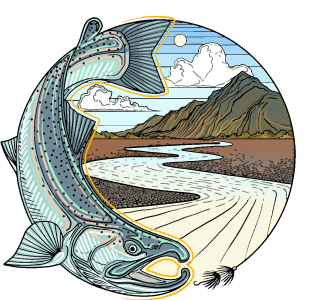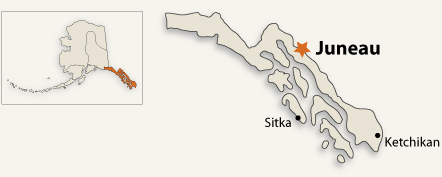Southeast: The Big Picture:
Southeast Alaska (aka the Panhandle or the Inside Passage) is a long, narrow coastal strip of land stretching nearly 500 miles from Ketchikan in the south to Yakutat in the north. The area is home to snow-capped coastal mountains, glaciers, primeval rainforests and great fishing. Most of the towns in SE can only be reached by plane or ferry. However, once you arrive in these towns, there are ample roads to drive to sample the local fishing.
Unlike its neighboring regions to the north, SE has few large rivers. Instead it has hundreds and hundreds of small, clear streams. With Southeast's voluminous amounts of rainfall, nearly every valley has a creek that drains it. Many of them rarely get fished as the sheer number of streams spreads out the anglers. With a little bit of effort, you can often find a stretch of river all to yourself.
Most Southeast Alaskan rivers are short, 3 to 6 miles in length, and are host to migrations of native trout, char, and salmon. A typical creek starts off in a heavily wooded forest and has fast currents interspersed with pools and undercut banks. As the creek nears its saltwater terminus the gradient flattens, slowing the current and deepening the creek as it winds through a meadow. The final part of the stream is the intertidal zone where the creek depth varies dramatically between high and low tide. As the tide moves in the salmon and trout move in with it. This often provides great fishing for bright salmon and hungry trout.
A word of caution: Southeast Alaskan tides range in size from 8 feet to over 20 feet! An angler needs to be careful not to get stranded on a flat by a flooding tide. As well, the mud can be sticky in places. Use caution, carry a tide book, and always fish with a partner. While tides can be predicted, bears can not. The United States Forest Service (USFS) has a tremendous amount of information on traveling and camping safely in bear country. We strongly recommend reading this and getting a clear understanding of the essential practices.
Fly Fishing in Southeast Alaska: When and Where to Go
Early Spring: April & May
Spring time in Southeast Alaska! After a long winter of tying flies and dreaming of casting a fly our finny friends are back. Steelhead are the first fish to enter our streams. Although some creeks get a trickle of fish all winter, the main run starts picking up in April with the peak of the run generally happening between May 1st and May 15th.
Just about every salmon stream in the area gets a small run of steelhead with approximately 50 to 200 fish. With runs this small you have to time it just right to be there when the fish come in. Some of the larger runs occur on Prince of Wales Island (POW) with runs numbering over 500 fish. The grand daddy of them all is the Situk River near the town of Yakutat. In recent years the run has numbered over 8000 steelhead!
Spring time also means great sea-run Dolly Varden and Cutthroat fishing. The salmon eggs that were laid last season have now hatched into baby salmon known as fry. Two species of fry (Pink Salmon and Chum Salmon) immediately migrate out of the streams where they were born and into the saltwater. Here they will spend the next few months swimming along the beaches and feeding the predatory Dolly Varden and cutthroat.
These starving piscavores have been eking out a living under the ice in the lakes for the past 6 months and are half-crazed in their pursuit of a good meal. The saltwater beaches and intertidal areas near river mouths are the best place to catch Dollies and Cutts while the fry are around. In some areas this fishery will extend well into the month of June.
Try the Olive & White Stinger Clouser Minnows, Gray & White AK Clousers, and our Saltwater Dolly Varden Selection to tempt these fish.
Early Summer: June
King Salmon are the prize in June! Most fly fishing for kings in Southeast is targeted at hatchery fish returning to the rearing area where they were released as smolts 3-5 years earlier. The usually deep-swimming kings move up into the top 10 feet of water and can be easily reached with a moderate sinking tip line. Rockstars in Pink or Chartreuse, Mr Bodangles, or the Chrome Crowbar will draw angry reactions from these bruisers. Juneau, Petersburg, and Ketchikan all have terminal King runs.
Don't forget: many beaches will still host good Dolly Varden fishing for most of June.
Summer: July & August
These two prime summer months represent the heart of the salmon runs in Southeast. If you are looking for sheer numbers of fish in the rivers this is the time! Pink salmon and chum salmon start returning in early July and huge numbers of fish are present from July 15th - August 15. Although fewer fresh fish will be coming in after August 15th, there can be pinks and chums in the rivers well into September. The Pink Humpy Hooker, Pink Starlite Leech, or our Pink and Chum Fly Selection are proven winners in Southeast for these fish.
Pinks and Chums are some of the most opportunistic spawners of all the salmon. This is a nice way of saying they will spawn in just about any freshwater they can find. They are found in many rivers throughout Southeast Alaska.
By July the salmon fry swim off into the deep Pacific Ocean and the Dollies have to find a new meal plan. Right on cue the salmon come in and start laying their eggs. Any stray eggs in the creek are vacuumed up by these voracious predators. Fishing a salmon egg imitation just downstream of spawning salmon will lead to instant action. Try using an Unreal Egg, Gorman Beadhead Egg, or our S.E. Kodiak Bead Selection.
Fall: September
The bittersweet month that brings us Silver salmon and spawning Dolly Varden, also marks the winding down of the fishing season. Many anglers say silvers are their favorite salmon. Their size, acrobatic fighting style, and willingness to take a fly makes them an ideal fish to chase on a fly rod. The silver run in southern Southeast (Ketchikan and Prince of Wales Island) often starts in early August. In northern Southeast (Juneau and Haines), the run starts in mid August and really gets going in early September. September 15th is considered the peak of the run. Our Silver Salmon Selection, Chartreuse/White Clouser Minnows, and Dolly Llamas are all indispensable for tying into a big Coho.
Although silvers return to creeks of all sizes, slightly larger systems with more side channels and tributaries provide silvers with the habitat they need to thrive. These systems can be found near just about every town in Southeast. Some of the biggest runs (and biggest fish) are found in the streams around Yakutat such as the Situk River.






Leave A Comment